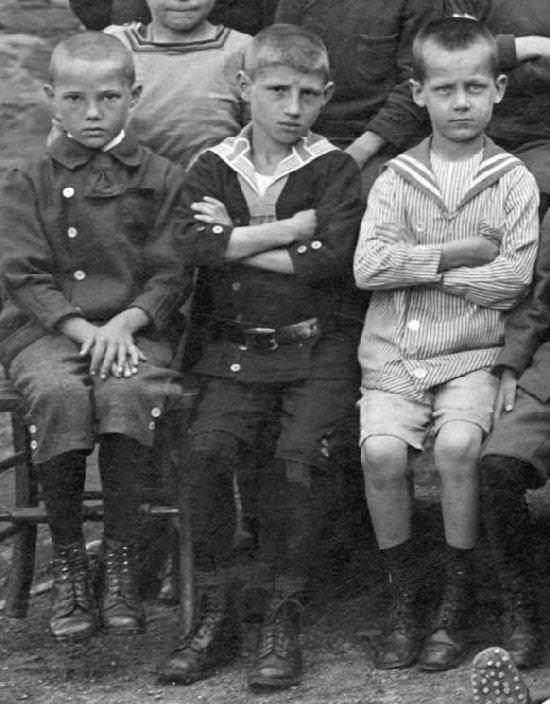
German School Wear during Imperial Germany: Individual Primary School Classes

Figure 1.--HBC has been sirprised at the variety of different sailor suiy styles worn by German boys in the early 20th century. Some are styles quite tradiotionally while others have styling we have not noted before. Notice tha kneepants varied from knee-length to well below the knee. We believe this class was photographed about 1905. Image courtesy of the MD collection.
|
At this time we have a few images of German school children during the the imperial period. Unfortunately they are all during the later 20th century pre-World War I era. years. We do not have much information on the 19th century. These inmages of school classes during the Imperial period show that uniforms were not worn, but that the sailor suit and middy blouse were especially popular for school wear. We notice quite a variety of other styles including square collar blouses and lederhosen as well as plain shotys and jackets. Most children wore heavy boot-like shoes, but a few c ame to school barefoot. Unfortunately many of the available school images are not dated. This makes it more difficult to floow changing fashion trends. We have attemped to estimate dates, but this in many cases is not an easy process. We welcome any insights as to the dates of these various calss portraits ftom out German readers.
We estimate that this undated German primary class photograph was taken about 1905, although this is only an estimate. There are no identifying marks on the photograph. There are no identifying marks on the photograph. The look of the boys, their clothes, and their hair styles strongly suggest that it was German. The absence of lederhosen suggest that it may have been a school in northern Germany. The teacher appaers to be 35-40 years of age, clearly a caeer teacher. There were women teachers, especially in promary school, but most teachers in boys' schools or for boys' classes were men--even for the younger primary grades. The absence of lederhosen suggest that it may have been a school in northern Germany. It is a high quality image allowing us to examine the boy's outfits in considerable detail. Sailor suits were very popular and came in a great variety of styles. None of the boys wear lederhosen nor any boys barefoot--both telling up somehing about the school and the chidren. Some of the boys have metal studs in the soles of their shoes to make them last longer.
We estimate that this undated class photograph was taken about 1910. It is a high quality image allowing us to examine the boy's outfits in considerable detail. Sailor suits were very popular and several boys wear lederhosen.
This class was photographed in 1913 and is especially interesting because the boys are shown inside their classroom.
This class of primary-age children were photographed in 1913. They wear mostly sailor suits and plain jackets, mostly without bows. Many of the girls wear pinafores.
This class of younger children looks to have been photographed about 1915. They wear mostly smocks and sailor suits, often with large bows.
This urban class looks to have been photographed late in World War I, perhaps 1917. All of the children wear kneepants and long stockings.
Christopher Wagner

Related Chronolgy Pages in the Boys' Historical Web Site
[Main Chronology Page]
[The 1850s]
[The 1860s]
[The 1870s]
[The 1880s]
[The 1890s]
[The 1900s]
[The 1910s]
Navigate the German school pages
[Main Imperial German school uniform page]
[Main German school uniform page]
[Weimar Republic]
[NAZI era]
[Post-war Years]
[Modern Germany]
Navigate the Relate Boys Historical Clothing Style Pages
[Main country page]
[Long pants suits]
[Short pants suits]
[Lederhosen]
[Kneesocks]
[Eton suits]
[Jacket and trousers]
[Blazer
[School sandals]
Navigate the Boys' Historical Clothing School Uniform Pages
[Main School Uniform Page]
[Australia]
[England]
[France]
[Germany]
[Italy]
[Japan]
[New Zealand]
[Scotland]
[United States]
Created: August 27, 2002
Last updated: August 27, 2002



